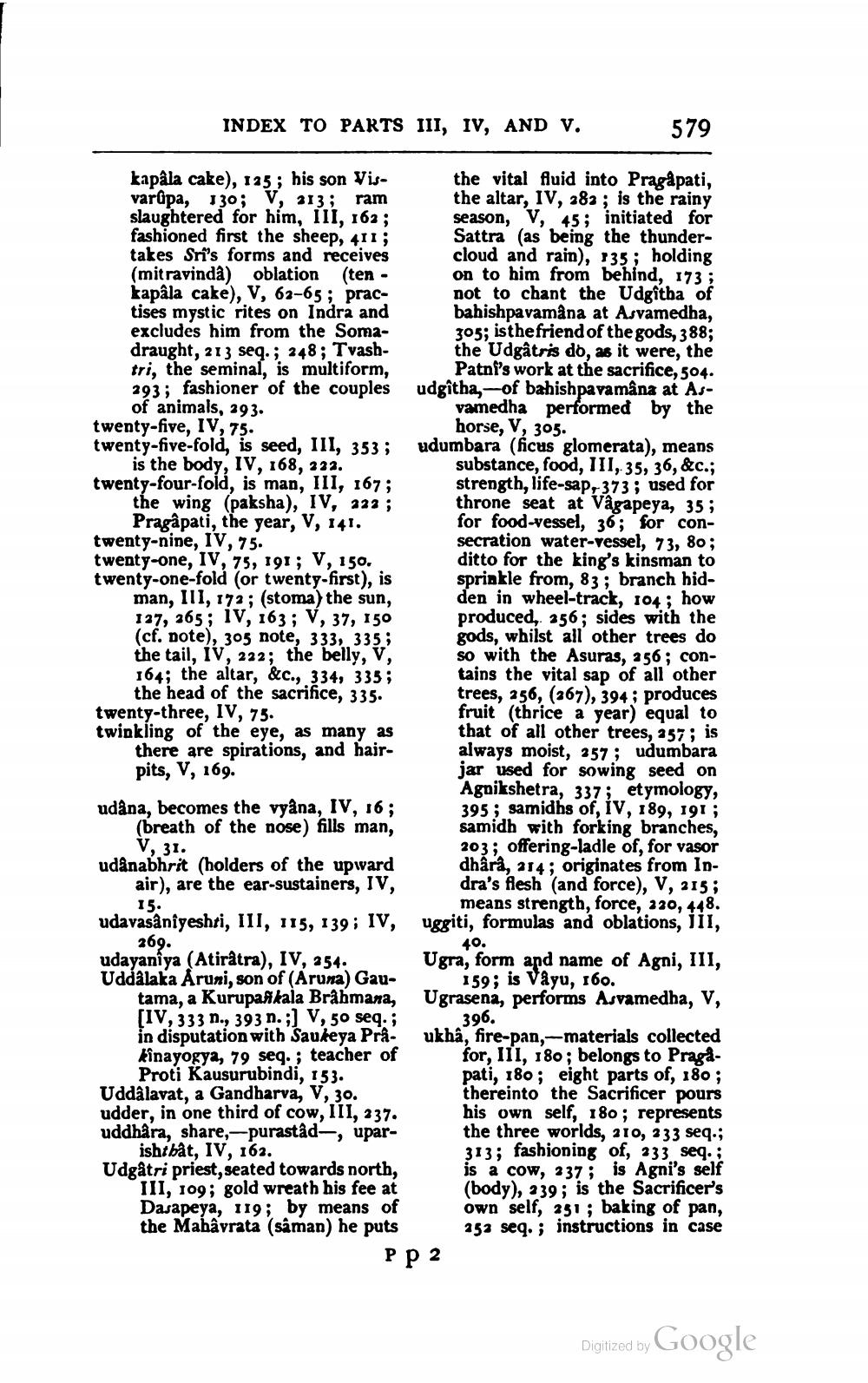________________
INDEX TO PARTS III, IV, AND V.
kapâla cake), 125; his son Visvarupa, 130; V, 213; ram slaughtered for him, III, 162; fashioned first the sheep, 411; takes Sri's forms and receives (mitravinda) oblation (ten - kapâla cake), V, 62-65; practises mystic rites on Indra and excludes him from the Somadraught, 213 seq.; 248; Tvashtri, the seminal, is multiform, 293; fashioner of the couples of animals, 293. twenty-five, IV, 75. twenty-five-fold, is seed, III, 353; is the body, IV, 168, 222. twenty-four-fold, is man, III, 167; the wing (paksha), IV, 222; Pragâpati, the year, V, 141. twenty-nine, IV, 75. twenty-one, IV, 75, 191; V, 150. twenty-one-fold (or twenty-first), is man, III, 172; (stoma) the sun, 127, 265; IV, 163; , 37, 150 (cf. note), 305 note, 333, 335; the tail, IV, 222; the belly, V, 164; the altar, &c., 334, 335; the head of the sacrifice, 335. twenty-three, IV, 75. twinkling of the eye, as many as there are spirations, and hairpits, V, 169.
udâna, becomes the vyâna, IV, 16; (breath of the nose) fills man, V, 31. udânabhrit (holders of the upward air), are the ear-sustainers, IV,
15.
udavasânîyeshri, III, 115, 139; IV, 269. udayaniya (Atirâtra), IV, 254. Uddâlaka Aruni, son of (Aruna) Gautama, a KurupaЯkala Brahmana, [IV, 333 n., 393 n.;] V, 50 seq.; in disputation with Saukeya Prâkinayogya, 79 seq.; teacher of Proti Kausurubindi, 153. Uddâlavat, a Gandharva, V, 30. udder, in one third of cow, III, 237. uddhâra, share,-purastâd-, uparishibât, IV, 162.
579
the vital fluid into Pragâpati, the altar, IV, 282; is the rainy season, V, 45; initiated for Sattra (as being the thundercloud and rain), 135; holding on to him from behind, 173; not to chant the Udgitha of bahishpavamâna at Asvamedha, 305; isthefriend of the gods, 388; the Udgâtris dò, as it were, the Patni's work at the sacrifice, 504. udgîtha,-of bahishpavamâna at Asvamedha performed by the horse, V, 305.
Udgâtri priest, seated towards north,
III, 109; gold wreath his fee at Dasapeya, 119; by means of the Mahâvrata (sâman) he puts
udumbara (ficus glomerata), means substance, food, III, 35, 36, &c.; strength, life-sap, 373; used for throne seat at Vagapeya, 35; for food-vessel, 36; for consecration water-vessel, 73, 80; ditto for the king's kinsman to sprinkle from, 83; branch hidden in wheel-track, 104; how produced, 256; sides with the gods, whilst all other trees do so with the Asuras, 256; contains the vital sap of all other trees, 256, (267), 394; produces fruit (thrice a year) equal to that of all other trees, 257; is always moist, 257; udumbara jar used for sowing seed on Agnikshetra, 337; etymology, 395; samidhs of, IV, 189, 191; samidh with forking branches, 203; offering-ladle of, for vasor dhârâ, 214; originates from Indra's flesh (and force), V, 215; means strength, force, 220, 448. uggiti, formulas and oblations, III,
40.
Ugra, form and name of Agni, III, 159; is Vayu, 160.
Ugrasena, performs Asvamedha, V, 396.
ukhâ, fire-pan,-materials collected for, III, 180; belongs to Pragapati, 180; eight parts of, 180; thereinto the Sacrificer pours his own self, 180; represents the three worlds, 210, 233 seq.; 313; fashioning of, 233 seq.; is a cow, 237; is Agni's self (body), 239; is the Sacrificer's own self, 251; baking of pan, 252 seq.; instructions in case
PP 2
Digitized by
Google




